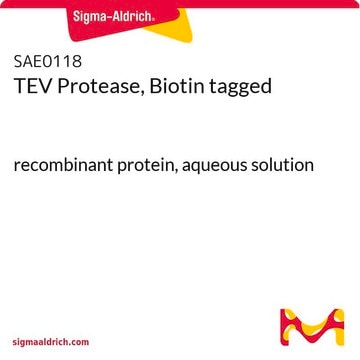SAE0110
HRV-3C Protease, Biotin tagged
Recombinant protein, 0.8-1.2 mg/mL, aqueous solution
Sinonimo/i:
Human Rhinovirus 3C Protease, Levlfqgp site protease, PreScission Protease
About This Item
Prodotti consigliati
Origine biologica
human (human Rhinovirus Type 14)
Ricombinante
expressed in E. coli
Saggio
≥90%
Forma fisica
aqueous solution
Attività specifica
≥5000 U/mg
PM
22 kDa
Concentrazione
0.8-1.2 mg/mL
tecniche
protein purification: suitable
Compatibilità
suitable for protein modification
applicazioni
life science and biopharma
Condizioni di spedizione
dry ice
Temperatura di conservazione
−20°C
Descrizione generale
This biotinylated HRV-3C protease is intended for on-column cleavage of fusion proteins with an HRV-3C cleavage site. It specifically cleaves the protein of interest from a column-bound fusion protein, leaving the fusion domain or tag bound to the affinity column (e.g. Ni-NTA column) and eluting only the protein of interest. This method is advantageous over post-elution cleavage for several reasons:
- It eliminates most impurities normally associated with purification on Ni-chelating columns.
- It allows gentler elution conditions, with added flexibility in the elution buffer composition. This can mitigate protein aggregation and inactivation.
After cleavage, the protease can be removed with any avidin-conjugated or streptavidin-conjugated beads. This product has been enzymatically biotinylated with no effect on its proteolytic activity. It has no additional protein purification tags. The product is supplied in aqueous buffer (0.8–1.2 mg/mL) with 20 mM Trizma®-HCl, pH 8.0, 200 mM NaCl, 1 mM TCEP, and 50% (v/v) glycerol.
Nota sulla preparazione
Note legali
Codice della classe di stoccaggio
10 - Combustible liquids
Classe di pericolosità dell'acqua (WGK)
WGK 2
Punto d’infiammabilità (°F)
Not applicable
Punto d’infiammabilità (°C)
Not applicable
Certificati d'analisi (COA)
Cerca il Certificati d'analisi (COA) digitando il numero di lotto/batch corrispondente. I numeri di lotto o di batch sono stampati sull'etichetta dei prodotti dopo la parola ‘Lotto’ o ‘Batch’.
Possiedi già questo prodotto?
I documenti relativi ai prodotti acquistati recentemente sono disponibili nell’Archivio dei documenti.
Articoli
Proteases for biotinylated tag removal for protein purification workflows with related reagents and technical resources.
Il team dei nostri ricercatori vanta grande esperienza in tutte le aree della ricerca quali Life Science, scienza dei materiali, sintesi chimica, cromatografia, discipline analitiche, ecc..
Contatta l'Assistenza Tecnica.








